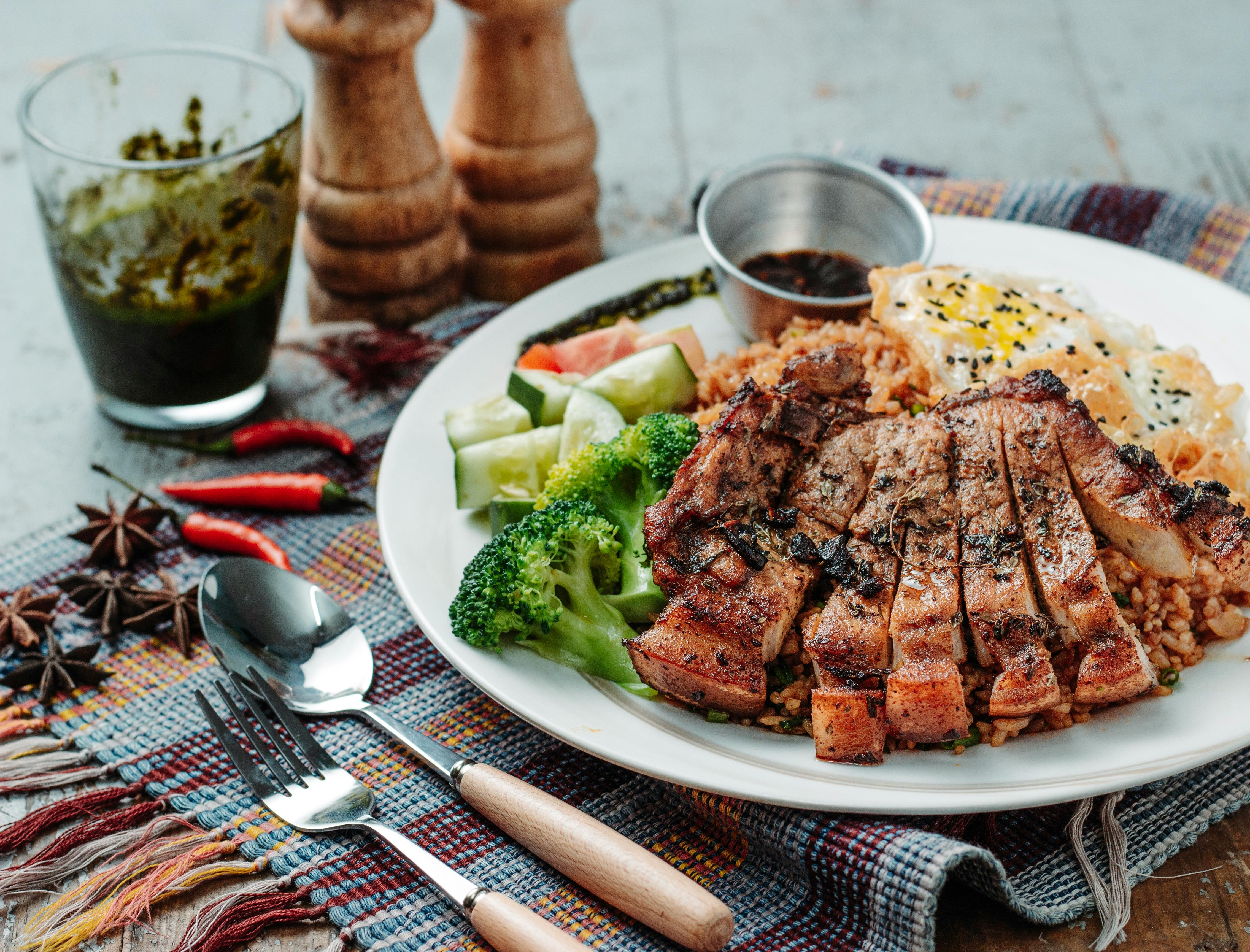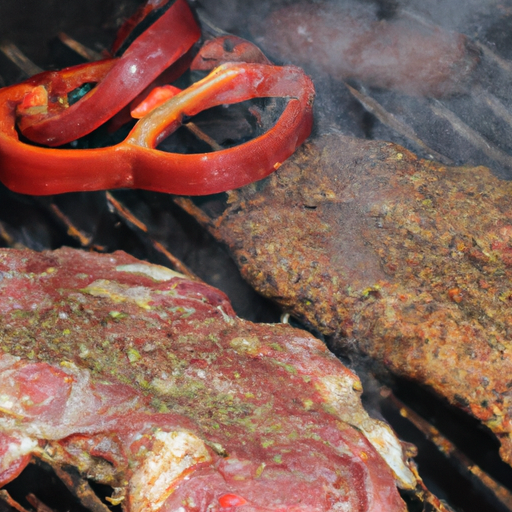Imagine the sizzling sounds, the aroma of perfectly charred meat, and the mouthwatering flavors that come with a delicious barbecue. Whether you’re a seasoned grill master or a novice, the art of grilling is something that can always be perfected. At Tastepan.com, we have compiled a collection of mouthwatering recipes and expert tips to help you elevate your grilling game. From juicy burgers to tender ribs, our tips for juicy and flavorful BBQ will ensure that every bite is a taste sensation. Get ready to impress your family and friends as you become a grilled food aficionado. Let’s fire up the grill and embark on a culinary adventure like no other.

Choosing the Right Grill
When it comes to grilling, choosing the right grill is the first step towards achieving delicious and flavorful BBQ. There are three main types of grills to choose from: gas grills, charcoal grills, and electric grills. Each type has its own unique features and advantages.
Gas Grills
Gas grills are known for their convenience and ease of use. They are powered by propane or natural gas and offer precise temperature control, allowing you to cook your food evenly. Gas grills heat up quickly and are perfect for those who want to grill on short notice or prefer a hassle-free grilling experience. Additionally, gas grills are relatively easy to clean and maintain.
Charcoal Grills
Charcoal grills are a favorite among BBQ enthusiasts who enjoy the smoky and authentic flavor that comes from cooking with charcoal. These grills use charcoal briquettes or lump charcoal to generate heat. While charcoal grills take longer to heat up and require more effort to clean, they offer a unique grilling experience. The smoky flavor imparted by charcoal and the ability to control the heat by adjusting the amount of charcoal makes charcoal grills a popular choice for serious grillers.
Electric Grills
Electric grills are a convenient and versatile option for those who live in apartments or have limited outdoor space. These grills require a power source and offer precise temperature control. Electric grills are easy to clean and maintain, and they eliminate the need for charcoal or propane. While they may not provide the same smoky flavor as charcoal grills, they are a great alternative for those who want to enjoy the grilling experience without the hassle of charcoal or gas.
Preparing the Grill
Once you have chosen the right grill, it’s important to prepare it properly before you start cooking. Proper preparation ensures that your food cooks evenly and minimizes the risk of sticking to the grates.
Clean the Grates
Before each use, make sure to clean the grates thoroughly. Use a grill brush to remove any residue or leftover food from previous grilling sessions. Cleaning the grates not only prevents your food from sticking but also helps maintain the longevity of your grill.
Preheat the Grill
Preheating the grill is essential to ensure that your food cooks evenly and retains its juices. Simply turn on your grill to the desired temperature and close the lid. Allow it to heat up for about 10-15 minutes before placing your food on the grates.
Oil the Grates
To prevent your food from sticking to the grill grates, it’s important to oil them properly. Using a pair of tongs, dip a folded paper towel in a high smoke-point oil, such as canola or vegetable oil. Rub the oiled paper towel over the grates before placing your food on them. This creates a non-stick surface and helps to achieve those beautiful grill marks.

Marinating and Seasoning
Marinating and seasoning your meat can take your grilling to the next level by enhancing the flavor and tenderness of your food. Whether you prefer marinating techniques or simply seasoning with rubs, the right combination of flavors can elevate your BBQ experience.
Marinating Techniques
Marinating involves soaking your meat in a mixture of marinade ingredients to infuse it with flavor and tenderize it. There are many marinade recipes available, ranging from simple combinations of oil, acid (such as lemon juice or vinegar), and spices to more complex blends with herbs, spices, and other liquids. Marinating times vary depending on the cut of meat, but it’s generally recommended to marinate for at least 30 minutes to several hours for maximum flavor.
Choosing the Right Seasonings
If you prefer to forego marinating, seasoning your meat with rubs can still provide incredible flavor. Rubs are mixtures of herbs, spices, and other seasonings that are applied to the surface of the meat before cooking. Whether you prefer a sweet and spicy rub or a savory blend, there are endless possibilities when it comes to choosing the right seasonings for your BBQ.
Applying the Seasonings
When applying marinades or rubs, make sure to coat your meat evenly for a consistent flavor profile. Use your hands or a brush to massage the marinade into the meat or rub the seasoning onto the surface. Allow the flavors to penetrate the meat for some time before grilling to ensure the best results.
Choosing the Right Cuts of Meat
Selecting the right cuts of meat plays a crucial role in the success of your BBQ. Different cuts of meat have varying levels of tenderness and fat content, which can affect the cooking time and flavor.
Beef
Beef is a popular choice for grilling, and there are several cuts that are well-suited for BBQ. Ribeye, T-bone, and New York strip steaks are known for their tenderness and rich flavor. Brisket and short ribs are ideal for slow-cooking and smoking, resulting in tender and flavorful meat.
Pork
Pork offers a wide variety of cuts that are perfect for grilling. Pork chops, tenderloins, and ribs are all popular choices. When grilling pork, it’s important to cook it to a safe internal temperature to ensure it is fully cooked and safe to eat.
Poultry
Chicken and turkey can be grilled to perfection, providing juicy and flavorful results. Chicken breasts, thighs, and drumsticks are common cuts for grilling. When grilling poultry, it’s essential to cook it thoroughly to avoid any risk of foodborne illness.
Seafood
Grilling seafood adds a delicious twist to your BBQ menu. From shrimp and salmon to scallops and lobster tails, there are countless options to choose from. Seafood cooks quickly, so it’s important to keep a close eye on it to prevent overcooking.
Vegetables
Grilling vegetables is a great way to add variety and nutrition to your BBQ. Bell peppers, zucchini, eggplant, and corn are just a few examples of vegetables that can be grilled to perfection. Brushing them with oil and seasoning them with salt and pepper can enhance their flavor and create a delicious side dish.

Grilling Techniques
Mastering different grilling techniques opens up a world of possibilities for creating mouthwatering dishes. Whether you prefer direct grilling, indirect grilling, smoking, or using a rotisserie, each method offers its own unique benefits.
Direct Grilling
Direct grilling involves cooking your food directly over the heat source. This method is best for thin cuts of meat that cook quickly, such as steaks, burgers, and hot dogs. To achieve a perfectly seared exterior and juicy interior, preheat your grill to medium-high heat and cook your food directly over the flames.
Indirect Grilling
Indirect grilling is ideal for larger cuts of meat that require slower and more even cooking. This method involves placing the food to the side of the heat source, allowing it to cook indirectly through the circulation of hot air. To achieve indirect grilling, preheat one side of your grill to medium-high heat and place the food on the other side to cook slowly. This method is great for cooking whole chickens, roasts, and ribs.
Smoking
Smoking adds a distinct and rich flavor to your BBQ. It involves cooking the food over a low, smoky fire for an extended period. To smoke food, you’ll need a smoker or a charcoal grill with a smoker attachment. Using wood chips or pellets, you create aromatic smoke that infuses the meat with flavor. Smoking is perfect for large cuts of meat, such as brisket or pork shoulder, that benefit from a slow and low cooking process.
Rotisserie
If you have a rotisserie attachment for your grill, it can be a game-changer for achieving succulent and evenly cooked meat. Rotisserie grilling involves skewering the meat and spinning it slowly over the heat source. This method allows the meat to baste in its own juices, resulting in a tender and juicy finish. Whole chickens, roasts, and even vegetables can be cooked to perfection on a rotisserie.
Grilling Times and Temperatures
Cooking your meat to the proper internal temperature is essential for food safety and to achieve the desired level of doneness. Here are some general guidelines for grilling times and temperatures for different types of meat:
Beef
For rare beef, aim for an internal temperature of 125°F (51°C). For medium-rare, aim for 135°F (57°C). Medium beef should reach 145°F (63°C), while medium-well is around 150°F (66°C). Well-done beef reaches 160°F (71°C).
Pork
Pork should be cooked to an internal temperature of 145°F (63°C) for medium-rare. Medium pork should reach 150°F (66°C), while medium-well is around 160°F (71°C). Well-done pork is cooked to 165°F (74°C).
Poultry
Chicken and turkey should reach 165°F (74°C) for safe consumption. It’s important to cook the meat until the juices run clear and there is no pink in the center.
Seafood
Fish and shellfish are generally cooked until they are opaque and flake easily with a fork. The internal temperature for seafood can vary depending on the type and thickness of the fish.
Vegetables
Grilling vegetables typically takes a shorter amount of time compared to meat. The aim is to achieve a tender texture with slightly charred edges. Cooking times vary depending on the type and thickness of the vegetables.
Properly Handling and Flipping Meat
Handling and flipping meat properly while grilling is essential to ensure even cooking and prevent any accidents or foodborne illnesses.
Using Tongs or Spatulas
When handling meat on the grill, always use tongs or a spatula to flip and move the meat. Avoid using a fork, as it can puncture the meat and cause juices to escape, resulting in a drier end result.
Avoiding Excessive Flipping
Flipping meat too frequently can interrupt the cooking process and prevent the development of a flavorful crust. Only flip your meat once or twice, depending on the thickness and cooking time.
Resting Meat Before Cutting
After your meat is cooked to the desired doneness, remove it from the grill and let it rest for a few minutes before cutting into it. Resting allows the juices to redistribute throughout the meat, resulting in a juicier and more flavorful end result.
Basting and Sauces
Basting and using sauces can add an extra layer of flavor and moisture to your grilled meats. Whether you prefer a homemade BBQ sauce or a simple basting liquid, the right techniques can take your BBQ to the next level.
Introduction to Basting
Basting involves applying a liquid, such as a marinade or sauce, onto the meat while it is grilling. This can enhance the flavor and help to keep the meat moist. Basting should be done towards the end of the cooking process to prevent the sugars in the sauce from burning.
Homemade BBQ Sauces
Making your own BBQ sauce allows you to customize the flavors to your liking. Whether you prefer a tangy and sweet sauce or a spicy and smoky flavor profile, homemade BBQ sauces can take your grilling to new heights. There are countless recipes available online to explore and experiment with.
Brushing Techniques
When applying sauces or marinades, it’s important to use a clean brush to prevent any cross-contamination. Brush the sauce onto the meat in thin, even layers, allowing each layer to set and caramelize slightly before adding the next. This creates a delicious glaze and prevents the meat from becoming overly saucy.
Grilling Safety
Grilling is a fun and enjoyable activity, but it’s important to prioritize safety to prevent any accidents or foodborne illnesses.
Keeping a Clean Cooking Environment
Maintaining a clean and organized cooking environment is crucial for safe grilling. Always start with a clean grill and utensils, and keep raw and cooked meats separated to avoid cross-contamination. Regularly clean and inspect your grill for any potential hazards, such as grease buildup or blockages.
Safe Handling of Raw and Cooked Meats
When handling raw meats, always wash your hands thoroughly before and after to prevent the spread of bacteria. Use separate cutting boards and utensils for raw and cooked meats to avoid cross-contamination. Be mindful of keeping your cooked meats covered and at safe temperatures to prevent spoilage.
Fire Safety
Grilling involves open flames, so it’s important to practice fire safety. Keep a fire extinguisher nearby and ensure it is in working condition. Never leave your grill unattended, and keep children and pets away from the grilling area. If using charcoal, allow the coals to cool completely before disposing of them.
Tips for Adding Smoky Flavor
If you’re looking to add a smoky flavor to your BBQ, there are several techniques you can try to achieve that coveted taste.
Wood Chips and Pellets
Using wood chips or pellets can infuse your food with a rich smoky flavor. Soak the wood chips in water or another liquid of your choice before adding them to the grill. The soaked chips can be placed directly on the coals or in a smoker box for gas grills. Experiment with different types of wood, such as hickory, mesquite, or applewood, to find your preferred smoky flavor.
Smoking Techniques
As mentioned earlier, smoking is a great way to add smoky flavor to your BBQ. Invest in a smoker or a charcoal grill with a smoker attachment to enjoy the benefits of this technique. With low and slow cooking, you can achieve incredible smoky flavors that permeate your meat.
Using Marinades and Rubs
Marinades and rubs can also contribute to the smoky flavor of your BBQ. Incorporate smoky ingredients, such as smoked paprika or chipotle peppers, into your marinades or rubs to enhance the smokiness. The longer you marinate your meat, the more opportunity the flavors have to penetrate the meat and create a smoky profile.
With these comprehensive tips and techniques, you’re now well-equipped to embark on your grilling journey. Whether you’re a beginner or a seasoned griller, these guidelines will help you achieve juicy and flavorful BBQ every time. So fire up your grill, experiment with different cuts of meat and seasonings, and enjoy the art of grilling!

